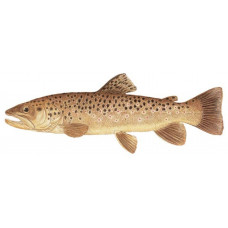Latin name
Salmo trutta
Other names
Brown trout (all forms). German brown, German trout, German brown trout, Loch Leven trout, European brown trout, English trout, von Behr trout, brownie, sea trout, lake trout, brook trout, river trout. River and stream brown trout. Danish: baekørred; Finnish: tammukka, purotaimen; French: truite commune; German: bachforelle; Norwegian: bekkaure; Polish: pstrag potokowy; Russian: forel strumkova; Swedish: bäcköring. Brown trout in lakes Danish: søørred; Finnish: jarvitaimen; French: truite de lac; German: seeforelle; Polish: troc jeziorowa; Russian: forel ozernaya. Sea trout, or sea-run brown trout. Danish: havørred; Dutch: zeeforel; French: truite de mer; Gaelic: breac; German: meerforelle; Italian: salmo trota; Norwegian: aure orret; Russian: losos taimen; Spanish: trucha marina; Swedish: öring.
Identification
The brown trout gets its common name from its characteristic olive green, brown or golden brown body color. The belly is white or yellowish, and there are many dark spots on the back and sides, sometimes surrounded by a pale halo. There are spots on the head and fins along the back, and rusty red spots on the flanks. There is a small fat fin in front of the tail, sometimes with a reddish tinge. Sea-run browns have a more silvery coloration and the spots are less pronounced. Inhabitants of large lake systems, especially the Great Lakes of North America, also have silvery coloration, dark spots without halos, and no colored spots.
Distribution
Brown trout can be found in rivers and lakes throughout most of North America, with the exception of the southernmost American states, the northernmost regions of Canada, and Alaska. It is also found in some coastal rivers from Long Island, New York to the Maritime Provinces and Quebec.
Habitat
Brown trout prefer cool, clear streams and lakes with temperatures between 54° and 65°F. They can survive and thrive in temperatures from 65° to 75°F, which is warmer than most other trout species can tolerate, but they do best in streams where summer temperatures do not exceed 68°F. In streams and rivers, they are wary and elusive fish that seek shelter more than other salmonids, hiding in undercut banks, stream debris, surface riffles, rocks, and deep puddles. They also seek shelter under overhanging vegetation.
Size
Brown trout can live up to 18 years, but most live no more than 12 years. Sea trout can spend up to 9 years in the ocean. Most river and stream fish are 9 to 14 inches long and weigh up to 4 to 5 pounds, rarely growing more than twice their size, although there are notable exceptions. Large river and lake specimens can grow to enormous sizes. The North American record, caught in 1992, is 40 pounds, 4 ounces.
Life history and Behavior
Brown trout spawn in the fall and early winter (October through February) in rivers or tributaries of lakes or large rivers. They return to the stream where they were born, selecting spawning sites in the upper reaches of rivers, at the head of riffles, or in the tail of the basin. The selected sites have good water flow through the gravel bottom. The female uses her body to dig a nest (redd) in the gravel. She and the male can spawn there several times. After spawning, the females cover the eggs with gravel and the adults return downstream. The eggs develop slowly over the winter and hatch in the spring. A good flow of clean, well-oxygenated water is required for successful egg development. Yearling brown trout move to cobble and grooved areas. Adults live in deeper water and are most active at night. They become sexually mature in their third or fifth year, and many of them repeat spawning. In addition to moving upstream to spawn, adults usually stay in the same place in the river, moving little to no other parts of the stream. Other individuals move into or out of estuaries in the spring or fall. In seawater populations, brown trout spend 2-3 years in freshwater, then migrate downstream to spend one or two growing seasons in coastal waters near river mouths and estuaries, where they feed on small fish and crustaceans. Most return to their home streams to spawn. In lakes, brown trout seek out preferred temperature levels and stay in deeper water during the summer months and in shallower water during the spring and fall when the water is colder. After the ice melts, they stay in shallow water and coastal areas, often around warmer tributaries, but move deeper as the surface warms.
Food and feeding habits
Brown trout are predators and consume aquatic and terrestrial insects, worms, crustaceans, mollusks, fish, salamanders, and even tadpoles or frogs. In small streams, their diet may consist mainly of insects, but in larger streams or where there are many baitfish, it may also include a variety of small fish. In large lakes, other fish, especially abundant pelagic schooling species such as alewives, make up the main diet. Small fish are the main food for sea trout.
Reproduction
No information
Interesting Facts
When catching insects, fish like the Brown trout rely mostly on their eyesight. But they also use their lateral line to feel the vibrations made by bugs falling into the water.
| Classification | |
| Phylum | Chordata |
| Class | Actinopterygii |
| Squad | Salmoniformes |
| Family | Salmonidae |
| Genus | Salmo |
| Species | S. trutta |
| Features | |
| Conservation status | Least Concern |
| Habitat | Pelagic |
| Life span, years | 20 |
| Maximum body weight, kg | 27 |
| Maximum length, cm | 140 |
| Sailing speed, m/s | No information |
| Threat to people | Edible |
| Way of eating | Predator |


